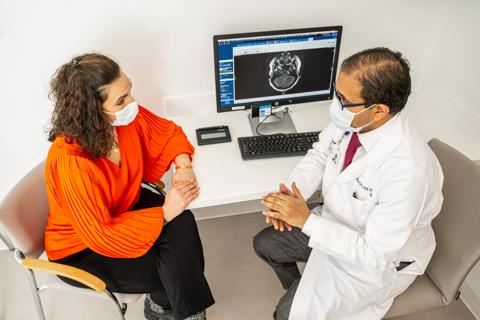Advertisement
Response in patient subgroups shows promise, however

Despite promising results in previous small phase 1 and 2 trials, Cleveland Clinic researchers conducting a larger multicenter phase 2 trial for patients with myelodysplastic syndromes (MDS) and chronic myelomonocytic leukemias (CMML) did not find improved overall response rates (ORR) with azacitidine in combination with lenalidomide or vorinostat.
Advertisement
Cleveland Clinic is a non-profit academic medical center. Advertising on our site helps support our mission. We do not endorse non-Cleveland Clinic products or services. Policy
The study found that higher-risk MDS patients treated with azacitidine plus lenalidomide or azacitidine plus vorinostat had a similar ORR to patients treated with azacitidine monotherapy.
Researchers did conclude, however, that specific patient subgroups – such as those with CMML or those with normal cytogenetics or chromosome 5 abnormalities – may derive some benefit from azacitidine-based combinations.
Results of the multicenter trial, which included 277 patients, were presented at the 57th American Society of Hematology Annual Meeting & Exposition in December in Orlando, Fla.
MDS and CMML are bone marrow cancers that have the potential to transform into acute myeloid leukemia (AML). As many as 20,000 new cases are diagnosed each year in the U.S.
Three drugs approved by the FDA for treating MDS and its subtypes are azacitidine, decitabine and lenalidomide. Additionally, the small molecule inhibitor vorinostat, when tested in phase 1 and 2 trials in combination with azacitidine in patients with higher-risk MDS, had a 70 percent overall response rate. Lenalidomide has also been combined with azacitidine in the phase 1 and 2 settings of 36 patients, with an ORR of 72 percent.
“The overall response rates for these drug combinations was twice as high as had been seen previously with azacitidine alone, which was exciting and a clear justification for the present study, in which we compared the combinations to the single drug,” said the larger study’s lead author Mikkael A. Sekeres, MD, MS, Vice-chair for Clinical Research and Director of the Leukemia Program at Cleveland Clinic’s Taussig Cancer Institute.
Advertisement
Because of the activity seen with azacitidine in combinations, researchers designed a multicenter, randomized, three-arm phase 2 study to examine azacitidine combined with lenalidomide or with vorinostat versus azacitidine monotherapy in patients with higher-risk MDS and CMML to determine if combination therapy could improve the response rate over monotherapy.
Eligibility criteria included higher-risk MDS or CMML with <20 percent blasts, age >18 years, and ECOG performance status of 0-2, plus no previous treatment with any of the study drugs, nor allogeneic transplantation, nor radiation or chemotherapy in the previous 12 months. The primary endpoint was overall response rate.
Between June 2012 and June 2014, 282 patients were enrolled from 90 centers in the U.S. and Canada. Five patients were ineligible, leaving 277 – 92 in the first arm, 93 in the second, 92 in the third. The median age was 70 years (range, 28-93), and 85 patients (31 percent) were female. Patients received a median of 22 weeks of therapy.
With a median follow-up among patients still alive at 19 months, the ORR for the entire cohort was 39 percent:
• Azacitidine ORR: 38 percent
• Azacitidine plus lenalidomide ORR: 49 percent
• Azacitidine plus vorinostat ORR: 27 percent
For CMML patients, the ORR was significantly higher among those receiving azacitidine plus lenalidomide than for those receiving azacitidine monotherapy (68 percent versus 28 percent).
The median overall survival (OS) for the entire cohort was 17 months:
Advertisement
• Azacitidine patients OS: 15 months
• Azacitidine plus lenalidomide patients OS: 19 months
• Azacitidine plus vorinostat patients OS: 17 months
Response rates in select cytogenetic subgroups were better for combinations than for azacitidine alone, as was overall survival following failure of the single drug or drug combinations, implying a deeper response to the combinations.
“The data for CMML patients was certainly intriguing; that we were able to identify patient subgroups who may benefit from combinations holds a lot of promise for future studies,” says Dr. Sekeres. “One troubling aspect of this study was that patients receiving combinations were removed from therapy prematurely, and that was associated with worse survival.”
Patients continued treatment until treatment failure, defined as disease progression, relapse, significant or unresolved toxicity, or lack of response, according to the abstract.
Dr. Sekeres concludes, “As a community, we need to be better about treating MDS patients for longer periods of time before declaring that therapy does or does not work.”
Researchers observed that the ultimate measure of a clinically meaningful endpoint is overall survival, and that this trial was not powered to assess differences in OS among treatment groups.
Advertisement
Advertisement

Study measures real-world outcomes for relapsed or refractory large B-cell lymphoma

Optimized responses in transplant- and CAR T-cell therapy-eligible patients

Findings from large database important to inform clinical practice

Socioeconomic disparities have a notable influence on access to allogeneic hematopoietic cell transplant

What’s coming up at ASH and beyond

Blinatumomab plus chemotherapy improves overall survival and relapse-free survival over chemotherapy alone

First-ever U.S. population-level retrospective analysis reveals many patients with systemic mastocytosis need faster intervention

Global R&D efforts expanding first-line and relapse therapy options for patients